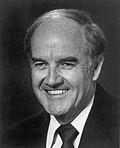1972 election
It was used by Democratic presidential candidate George McGovern in 1972. It backfired badly and became a byword for foolish and insincere exaggeration, and today is often used in irony or sarcasm. [3]

On July 25, 1972, just over two weeks after the 1972 Democratic Convention, McGovern's running mate for vice president, Thomas Eagleton, admitted the truth of news reports that he had received electroshock therapy for clinical depression during the 1960s, a fact kept secret from McGovern. However, McGovern had been running an emotional crusade against incumbent President Richard Nixon, with Nixon supporters counterattacking by suggesting that McGovern was crazy. The new evidence that his running mate had secretly undergone psychiatric treatment three times for mental illness destroyed the McGovern strategy. Eagleton was hospitalized in 1960 for four weeks for "exhaustion and fatigue". He was hospitalized for four days at the Mayo Clinic in 1964, and for three weeks in 1966. He twice underwent electroshock therapy for depression. [4] Influential Democrats questioned both Eagleton's ability to handle the office of Vice President and McGovern's competence in choosing top officials. In response to intense pressure from the media and party leaders that Eagleton be replaced, McGovern announced that he was "1000 percent behind Tom Eagleton, and I have no intention of dropping him from the ticket". [5]
McGovern subsequently consulted with psychiatrists, including Eagleton's own doctors, who advised him that a recurrence of Eagleton's depression was possible and could endanger the country should Eagleton become president. Consequently, on July 31, McGovern announced that he had reversed his position "in the interest of the nation", and Eagleton announced that he was withdrawing his candidacy to prevent continued diversion from greater issues, and for the sake of party unity. [6] [7]
Theodore H. White, the journalist who followed the campaign most closely, reports that the "1000 percent" phrase was repeatedly mentioned over and over again by voters and damaged McGovern even more than his actual reversal of support for Eagleton. [8] The reason, according to Trent and Trent, was that McGovern's rhetoric throughout the campaign had been intensely moralistic and hyperbolic: he repeatedly emphasized his moral superiority over Nixon and Nixon's supporters. For example, in one speech McGovern attacked some Nixon advocates as "lousy, bitter, paranoid, predictable, despicable, obnoxious propagandists who are consistently wrong and who write nothing good about any candidate more liberal than Genghis Khan". But now his own extreme language was exposed as fraudulent by his use of the 1000% metaphor. [9]
